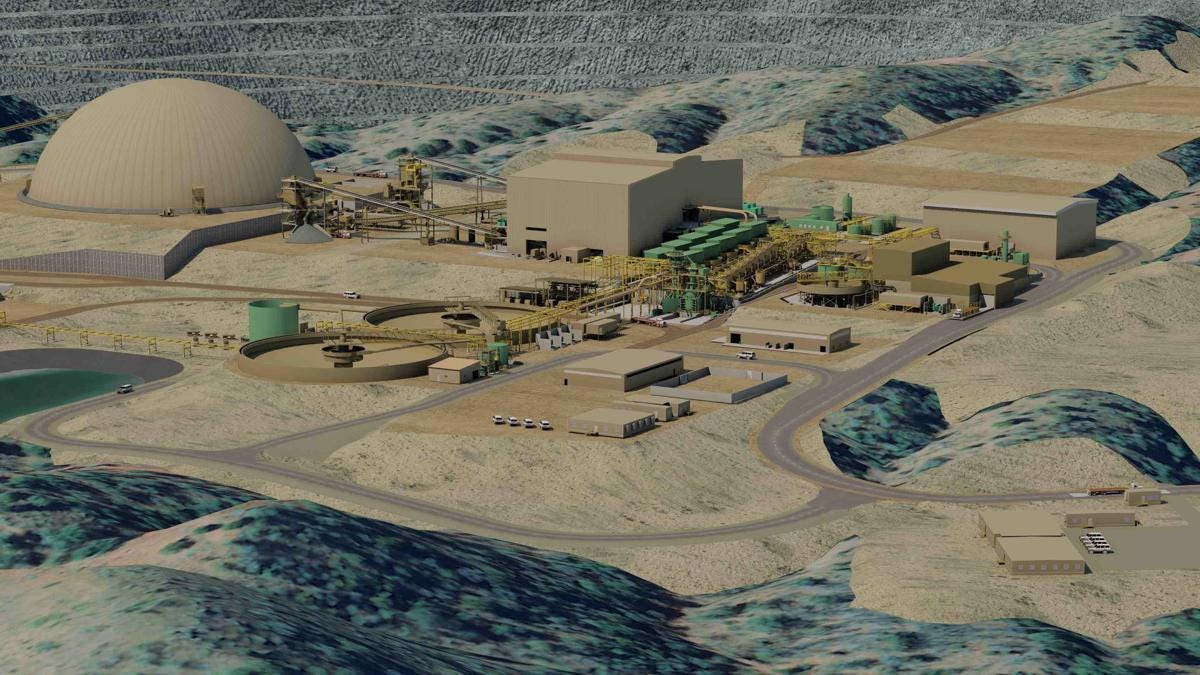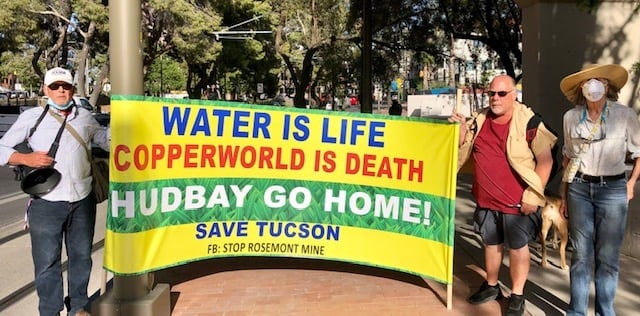💧🏔️ Copper World (Rosemont) Mine Wins Water Battle: Tribes and Environmentalists Stunned
🦅🏜️ Sacred Land or Copper Mine? Arizona's Dilemma Deepens 🌵⚖️ 19th Century Law Paves Way for 21st Century Mine in Arizona
😽 Keepin’ It Simple Summary for Younger Readers
👧🏾✊🏾👦🏾
🏔️💧 In Arizona, there's a big argument about digging for copper in the mountains. Some people want to build a mine called Copper World because we need copper for things like phones and electric cars. But other people, including Native American tribes, are worried it might hurt the water and animals that live there. The mine just got an important permission to use water, which made the people who want to build it very happy. But the people who don't want the mine are still trying to stop it. It's a tricky problem because we need copper, but we also need to take care of nature. 🐾🌵
🗝️ Takeaways
🏆 Hudbay Minerals secures crucial aquifer protection permit for Copper World project
🔄 Project rebranded from Rosemont to Copper World, shifting focus to private land
🌊 Environmental groups and tribes fear significant impacts on water resources
📜 1872 Mining Law continues to influence modern mining projects
💼 Economic benefits touted by company, but disputed by opponents
🔬 Air quality permit still pending, final major hurdle for initial phase
🏔️💧 Copper World Mine Advances Despite Environmental Concerns

The controversial Copper World mining project in southern Arizona cleared a major hurdle in October 2024 when opponents declined to appeal the state's approval of a crucial aquifer protection permit.
This development marks a significant step forward for the mine's Canadian owner, Hudbay Minerals Inc.. Still, it continues to alarm environmental groups and local tribes who fear devastating impacts on the region's water resources and ecosystems.
🕰️⚔️ A Long-Fought Battle Enters a New Phase
The saga of this massive open-pit copper mine proposed for the Santa Rita Mountains southeast of Tucson stretches back over a decade. Originally known as the Rosemont Mine, the project faced fierce opposition from its inception due to concerns about its environmental impact.
In 2019, plans for the Rosemont Mine on the mountains' eastern slopes were halted by a federal judge, who ruled that the U.S. Forest Service had improperly approved the company's plan to dump waste rock on public land. This setback led Hudbay to pivot, rebranding the project as "Copper World" and focusing development on private land on the western side of the Santa Ritas.
The name change from Rosemont to Copper World in 2021 signaled more than just a shift in location. It represented Hudbay's strategic move to sidestep federal regulations by concentrating operations on private property, thereby requiring only state and local permits. This maneuver has proven crucial in advancing the project despite ongoing environmental concerns.
📜💧 The Aquifer Protection Permit: A Critical Milestone
The recent decision by opponents not to appeal the Arizona Department of Environmental Quality's (ADEQ) approval of an Aquifer Protection Permit for Copper World marks a significant victory for Hudbay. This permit is essential for the mine's operations, as it regulates and requires monitoring of pollutant discharges from 16 planned facilities, including five open pits and massive tailings storage areas.
Despite strong opposition from environmental groups, local tribes, and some community members, the permit was allowed to stand.
Notably, Pima County Administrator Jan Lesher stated, "I do not believe there is a substantive basis for Pima County to appeal the issuance of the aquifer protection permit."
This assessment from a key local official effectively cleared the way for the permit to move forward unchallenged.
🌿🚫 Environmental Concerns Persist
While Hudbay celebrates this regulatory win, environmental advocates and tribal representatives continue to voice serious concerns about the project's potential impacts:
Water Resources: Critics argue that the mine's operations could contaminate groundwater and deplete already stressed aquifers in the arid region.
Ecosystem Disruption: The Santa Rita Mountains are known for their biodiversity and host numerous endangered species. The mine's footprint threatens to fragment and destroy critical habitats.
Air Quality: Dust from mining operations, particularly concerning the spread of valley fever spores, remains a significant worry for nearby communities.
Cultural Heritage: Local tribes, including the Tohono O'odham and Pascua Yaqui, have expressed deep concern about destroying ancestral lands and sacred sites.
Long-term Environmental Legacy: Questions persist about the effectiveness of Hudbay's reclamation plans and the potential for long-lasting environmental damage.
📜⛏️ The Role of the 1872 Mining Law
Central to the controversy surrounding Copper World is the General Mining Act of 1872, a 19th-century law still governing hardrock mining on federal lands in the United States. This antiquated legislation allows mining companies to extract valuable minerals from public lands without paying royalties and gives mining precedence over other land uses.
Critics argue that this law is woefully outdated. It fails to account for modern environmental concerns and gives mining interests an undue advantage over conservation and other public land uses. The law's provisions have made it challenging for federal agencies to deny mining projects, even when significant environmental impacts are anticipated.
In the case of Copper World, Hudbay's strategic shift to private land has allowed them to circumvent some federal oversight. However, the 1872 law still shapes the overall regulatory landscape for mining in the region.
🔮🏗️ Looking Ahead: The Future of Copper World
With the aquifer protection permit secured, Hudbay is poised to move forward with its plans for Copper World. However, the company still needs to obtain an air quality permit from ADEQ, which is currently pending. This would clear the final major regulatory hurdle for the project's initial phase if approved.
Hudbay envisions a two-phase approach for Copper World:
Phase I: A 20-year operation on private land, producing an average of 85,000 metric tons of copper annually.
Phase II: An expansion onto federal land, requiring additional permits and potentially extending the mine's life well beyond 20 years.
The company touts the project's economic benefits, including job creation and tax revenue. It also emphasizes its commitment to producing "Made in America" copper for domestic use, positioning the mine as crucial for the green energy transition.
However, opponents remain unconvinced by these arguments. Save the Scenic Santa Ritas and other environmental groups have vowed to continue their fight against the mine through other regulatory and legal avenues.
🌍💼 A Microcosm of Larger Debates
The Copper World controversy encapsulates many tensions in contemporary debates about resource extraction, environmental protection, and economic development. It raises difficult questions about balancing the demand for minerals crucial to modern technologies and green energy infrastructure with the need to preserve ecosystems, protect water resources, and respect indigenous rights.
As the project becomes a reality, it will likely remain a flashpoint for these more extensive discussions. Copper World's outcome could have far-reaching implications for mining policy, environmental regulation, and community rights not just in Arizona but across the United States.
For now, Hudbay appears to have the upper hand with crucial permits in hand. However, as the history of this long-fought battle shows, the future of mining in the Santa Rita Mountains is far from settled. Environmental advocates, tribal leaders, and concerned citizens continue to watch closely, ready to challenge each step of the mine's development in their ongoing effort to protect southern Arizona's land, water, and communities.







This is a horribly perverse decision. Of course, "conservative" judges can and will cite the 1872 law. Since that legislation has not been repealed, it is still "on the books," and thus the Court must "uphold the law." Nevertheless, we must wonder what happened to common sense! This ruling underscores the harsh, ugly reality that the United States does NOT have a "justice" system. It has a "legal" system instead. Shameful!